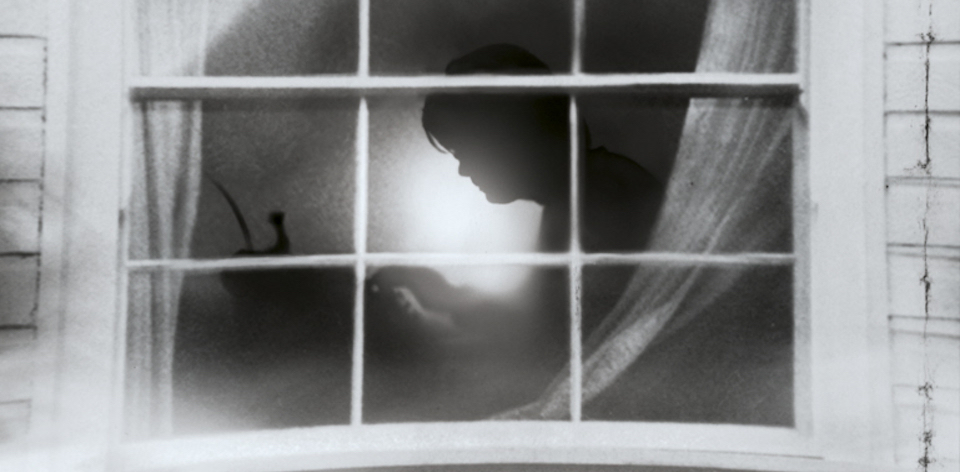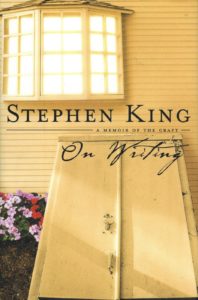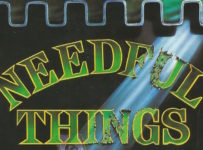Welcome to the feature column that explores a decent number of Stephen King’s books in the order they were published! (More or less!)
This month, the Club added a bonus book: following Danse Macabre, we’ve added On Writing as a companion piece written decades later.
In 1999, the world almost lost Stephen King. Struck by a minivan while walking in his native Maine, it took several operations and a whole lot of physical therapy before the master was even close to sitting upright and writing again. ON WRITING: A MEMOIR OF THE CRAFT (2000) represents King’s first published work following the accident, and is as much about a renewal of dedication as it is about the craft.
King started working on this book in 1997, around the same time that he was writing Bag of Bones. It begins as a memoir of sorts (in “C.V.”), not so much recounting his life but his early attempts at publication, meeting his wife, and his work as a teacher. King says in the first foreword, it’s about “how I came to the craft, what I know about it now, and how it’s done.” Some of the memories are amusing (accidentally using poison ivy for toilet paper), reassuring (King had a spike of rejection letters), or heartbreaking (the death of his mother).
Acting as a kind of spiritual follow-up to 1981’s Danse Macabre, the disjoined memories in this first section aren’t strictly autobiographical, but lay some groundwork for the lessons on writing. There’s an immediate difference to his earlier non-fiction, and the additional decades have made King’s style more confident, fluid, and less flippant. When he talks about his alcoholism and drug abuse, King is far from flippant. This is a King who has gone through the bottle with his demons and come out the other side. Comparing his addiction to the psychotic character in Misery, he concludes, “Annie was coke, Annie was booze, and I decided I was tired of being Annie’s pet writer.”
The rest of the book is dedicated to advice on the craft. After giving us a few reasons to pay attention in “What Writing Is,” King pulls out his big toolbox of basics that all writers should know. Covering vocabulary, grammar, and style, he has some strong opinions. “I believe the road to hell is paved with adverbs, and I will shout it from the rooftops.” He concludes by encouraging fledgling writers to overcome their fear and make better choices by choosing the right tools.

Indeed, much of King’s advice could be classified as common sense, but not always common practice. The largest section of the book is simply called “On Writing,” delving into some more practical advice about putting words on paper or a computer screen. King never gets too deep into the weeds in this slender volume, and is often as dismissive of television and critics as he was in Danse Macabre. He values story over plot, and avoiding conscious moral conclusions. “If you want to be a writer, you just do two things above all: read a lot and write a lot.” He’s not wrong, and it is a practice I’ve personally adopted. Yet King’s reverential attitude to “the story” may also discourage as much as it inspires. Like Danse Macabre, there’s a reading list of works King considers to be exemplars, and these may be a good place to start the King Regime if you’re still keen.
The notion of the Intended Reader is the most powerful advice in the book. Rather than write for everyone and everything, King is an advocate of writing for an Intended Reader. King reader is his wife Tabitha. King is not alone in this thought: Wolfgang Iser and Martin Barker have written about the “implied reader” at length. Earlier in the book, King talks about the telepathy shared between writer and the reader, which (whether consciously or not) taps into Umberto Eco’s notion of textual cooperation that gives the reader an essential role in the process of making meaning. (See: Lucie Guillemette and Josiane Cossette’s article for a deep dive). King doesn’t discuss these theories, nor does he say whether he’s influenced by them, but King’s track record and extensive reading list is indicative that he’s at least aware of them. Indeed, King would later fictionalise some of the content in the last few books in The Dark Tower cycle, writing his accident and the importance of the reader/creator relationships into the story.
The “On Living” postscript, written after his painful return to the work desk, recounts that accident in detail. It’s comparable to his earlier account of living with addiction, showcasing that the road to recovery was just as much about self-awareness as it was about getting back in the saddle. It was surprising to learn just how severe some of King’s injuries were, and gives us some insight into why he almost quit writing for good in 2002. (Thankfully, the reading public has been treated to almost 30 publications since then).
ON WRITING will probably work best for Constant Readers and other fans when it’s written for process junkies, such as the difficult journey towards finishing The Stand. Whether you are an aspiring writer, an established scribe, or just curious about what makes King’s mind tick, there will be something in here for you. It may not provide all the answers you want, but for that you may need to go back to his novels. To paraphrase Steve Martin in the movie Grand Canyon, all of life’s riddles are answered in the books.





